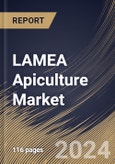technology is increasingly integrated into beekeeping practices through precision beekeeping techniques. IoT (Internet of Things) devices, sensors, and monitoring tools enable beekeepers to gather real-time data on hive conditions, bee behavior, and environmental factors. Data analytics facilitates predictive modelling for hive management, disease detection, and optimization of pollination services. These technological advancements augment the productivity and efficacy of beekeeping endeavours.
Acoustic sensors and IoT devices equipped with cameras can capture and analyze bee behavior. This includes monitoring the frequency and types of sounds produced within the hive, which can provide insights into the health and activities of the colony. Visual data from cameras enables beekeepers to observe behaviours such as swarming, foraging patterns, and potential signs of stress or disease.
Brazil has diverse ecosystems and a wide variety of flora. This diversity provides ample forage for bees, allowing beekeepers to produce honey with distinct flavors and characteristics. The country has witnessed the growth of large-scale commercial beekeeping operations, contributing to increased honey production. As per the data from the Government of Brazil, in 2020, the nation exported US$ 98.5 million of natural honey, an increase of 44% more than in 2019. The volume exported was 45.7 thousand tons, a growth of 52%. Therefore, increasing honey exports and food and beverage sector growth in LAMEA will help in the expansion of the regional market.
The Brazil market dominated the LAMEA Apiculture Market, by Country in 2022, and would continue to be a dominant market till 2030; thereby, achieving a market value of $347.7 Million by 2030. The Argentina market is showcasing a CAGR of 7.2% during (2023 - 2030). Additionally, The UAE market would register a CAGR of 6.4% during (2023 - 2030).
Based on Application, the market is segmented into Food & Beverage, Pharmaceuticals, Personal Care & Cosmetics, and Others. Based on Type, the market is segmented into Honey, Royal Jelly, and Beeswax. Based on countries, the market is segmented into Brazil, Argentina, UAE, Saudi Arabia, South Africa, Nigeria, and Rest of LAMEA.
List of Key Companies Profiled
- Capilano Honey Ltd.
- YS Organic Bee Farms
- Dabur India Ltd.
- NOW Health Group, Inc.
- Koster Keunen, Inc.
- Barkman Honey, LLC
- Fairfield Organics, LLC
- Strahl & Pitsch, LLC.
- Miller's Honey Company
- Durham's Bee Farm, Inc.
Market Report Segmentation
By Application (Volume, kilo Tonnes, USD Billion, 2019-2030)- Food & Beverage
- Pharmaceuticals
- Personal Care & Cosmetics
- Others
- Honey
- Royal Jelly
- Beeswax
- Brazil
- Argentina
- UAE
- Saudi Arabia
- South Africa
- Nigeria
- Rest of LAMEA
Table of Contents
Companies Mentioned
- Capilano Honey Ltd.
- YS Organic Bee Farms
- Dabur India Ltd.
- NOW Health Group, Inc.
- Koster Keunen, Inc.
- Barkman Honey, LLC
- Fairfield Organics, LLC
- Strahl & Pitsch, LLC.
- Miller's Honey Company
- Durham's Bee Farm, Inc.
Methodology

LOADING...








